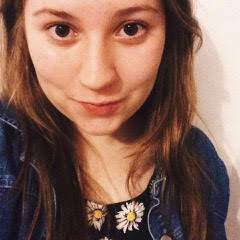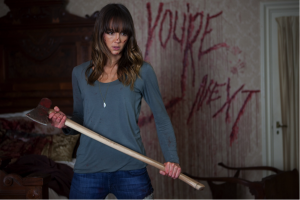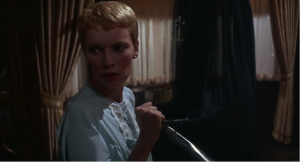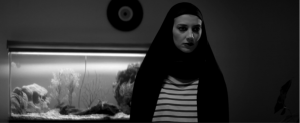By  Vesna Clark, Country to Canberra teen blogger.
Vesna Clark, Country to Canberra teen blogger.
As a horror fan and feminist, it is often difficult to find a horror or thriller film that is not entirely misogynistic and stereotypical of women. Most horror films will portray the “dumb blonde” and the “passive, shy brunette”. Both characters are exploited, sexualised and more often than not, killed off very early in the plot.
Horror films have a history for employing everyday female stereotypes that degrade and limit women. However, once in awhile I will come across a horror film that caters to my feminist beliefs and views, portraying a strong female protagonist and/or exploring women’s issues.
Some of these films mentioned only include the “final girl”, which is the female character who survives to the very end and confronts the killer, seen within old classics such as Halloween, Nightmare on Elm Street and Friday the 13th. This female will most likely exhibit intelligence, curiosity and vigilance.
You’re Next (2011)
Normally, modern horror/thrillers are a hit or miss for me, however You’re Next is definitely a hit in terms of entertainment, action and the female protagonist Erin, played by Sharni Vinson (an Australian!). When the Davison family are faced with a gang of masked, ax-wielding killers, it seems as though they are helplessly trapped. However, as panic ensues, Erin is the only one who can maintain a clear mind as we discover she was brought up in a survivalist camp. There is a number of times where Erin comes face to face with the masked killers, fighting them off while also attempting to bring the remaining family members to safety and sealing off the house.

The Babadook (2014)
What I love about this film is not only its evocative cinematography and compelling story line but the way in which it explores depression. The film tells the story of a single mother, Amelia and her troubled son. After reading the creepy story of ‘Mister Babadook’, strange events begin to occur and Amelia spirals into a depressive and anxious state that threatens her remaining relationships. Simultaneously, The Babadook subverts stereotypes typical of horror films including a young, sexualised protagonist presented as either a “whore” or “virgin”. However, Amelia is a fully grown woman who is in control of her sexual desires and needs. Thus, The Babadook presents a mulitifaceted female protagonist who is faced with an unwanted presence that is fuelled by Amelia’s grief and fear.
Carrie (1976)
Carrie is a story that caters exclusively to feminine issues, such as the stigma surrounding menstruation. Carrie, played by Sissy Spacek, is a young woman who is abused both physically and emotionally by her own mother and peers for ultimately “becoming a woman”. Throughout the film, she develops her telekinetic powers, using them as a weapon as she unleashes her revenge. Carrie defies the notion that her value as a female is inextricably linked to purity and instead constructs her own rules. In particular, the film focuses on not only “what men fear about women’s sexuality” (Stephen King) but also women fearing each other’s strengths. Spacek delivers an exceptionally powerful performance, communicating a striking tale of bloody revenge.
The Shinning (1980)
The first images that may spring to mind are twins, snow and elevators filled with blood. However, The Shinning also explores the progression and effects of an abusive relationship, depicted through Jack’s often violent and unpredictable behavior towards Wendy. Jack is consistently blaming Wendy for a lot of his own faults, calling her a “bitch” and a “sperm bank”. In complete isolation, the Overlook Hotel becomes a metaphor for the entrapment Wendy experiences within her abusive relationship. She is depicted as a caring, independent and resourceful, doing whatever she can in order to keep her and her son alive. As Jack’s insanity and rage increases, the chaotic snowstorm brews. Wendy is an incredibly brave female character, a definite must see.

Rosemary’s Baby (1968)
Rosemary’s Baby is a literal horror story of maternity where Rosemary’s husband arranges for her to be raped and impregnated by Satan. This is a story about the removal of women’s reproductive rights, as Rosemary’s body becomes a vessel for every other person’s use but her own. As she begins to recognise the strange behavior of her husband and elderly neighbours her concerns are dismissed as she is led to believe she is going crazy.
A Girl Walks Home Alone At Night (2014)
This quirky and gorgeous film follows a young female vampire who roams Iranian streets, spooking bystanders while in search for her next meal. The gothic and eerie film is successful in its gender reversal of vampire tropes. Amirpour depicts the vampire’s bloody and brutal encounters, in particular with a thug-like bully who takes her back to his house believing she is a prostitute, she reveals her fangs, showing that she is the real predator here and kills him. Amidst the blood sucking, a romantic relationship develops between the young female vampire and Arash, a young man who owns a lavish 1950s automobile. The relationship is centered on equal grounds as the vampire is not shown to be submissive around him, but still her calm and collected but intimidating presence shines through.

Horror/thriller films still have a long way to go in terms of representation of women, in particular women of colour. Almost all of the films mentioned above portray white protagonists. However, there are horror films such as Tales from the Crypt Presents: Demon Knight, 28 Days Later and Alien vs. Predator that depict strong black females.
If my reviews sparked your interest, I encourage you to watch. And moving forward, keep challenging those stereotypes in film that are holding women back.

